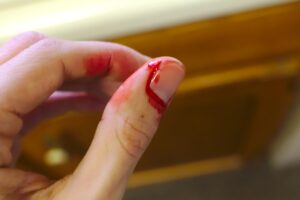Thumb Ligament Injury

The ulnar collateral ligament (UCL) is a strong band of tissue that is located on the inside of the thumb, connecting the bones of the thumb to the wrist. It provides stability and support to the thumb and helps it to move smoothly. Injuries to the UCL can result from activities that involve excessive stress on the ligament, such as falling, twisting, or jamming the thumb. These injuries are commonly referred to as “skier’s thumb” or “gamekeeper’s thumb.”
Cause of Thumb UCL Injury
UCL injuries to the thumb are most commonly caused by a sudden and forceful blow to the thumb, such as a fall or a blow to the thumb while playing a sport. This can cause the ligament to stretch or tear, resulting in pain, swelling, and instability in the thumb. Other factors that may contribute to UCL injuries include repetitive stress on the thumb, as well as underlying conditions such as arthritis or other joint problems.
Symptoms
The symptoms of a UCL injury can vary depending on the severity of the injury, but may include:
• Pain in the inside of the thumb, especially when gripping or pinching
• Swelling in the thumb
• Instability in the thumb
• Weakness in the thumb
• A popping or snapping sensation when the thumb is moved
• Difficulty using the thumb for everyday activities
Diagnosis
Diagnosis of a UCL injury typically begins with a physical examination of the thumb, including an evaluation of the thumb’s range of motion and stability. X-rays or other imaging tests may be ordered to determine the extent of the injury and to rule out any other underlying conditions. In some cases, further diagnostic tests, such as an MRI, may be needed to confirm the diagnosis.
Treatment for UCL Thumb Injury
Treatment for a UCL injury will depend on the severity of the injury and the underlying cause. Non-surgical treatment options include:
• Rest and immobilization: Using a splint or brace to immobilize the thumb and reduce stress on the ligament.
• Physical therapy: Exercises to improve the strength and flexibility of the thumb and wrist.
• Medications: Over-the-counter pain medications, such as ibuprofen or acetaminophen, can help to reduce pain and swelling.
In more severe cases, surgery may be required to repair the torn ligament. Surgery typically involves reattaching the torn ligament to the bone or reconstructing the ligament using a tendon from another part of the body.
UCL injuries to the thumb can cause significant pain, swelling, and instability in the thumb, making it difficult to perform everyday activities. Early diagnosis and treatment are essential to ensuring a full recovery and restoring normal thumb function. If you experience symptoms of a UCL injury, it is important to seek prompt medical attention to determine the best course of treatment.
